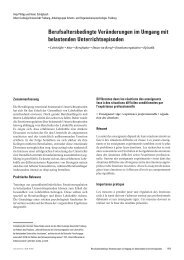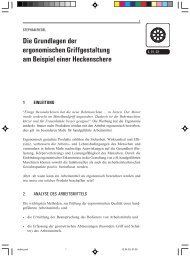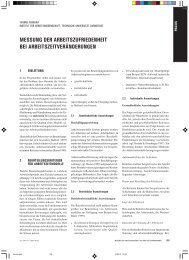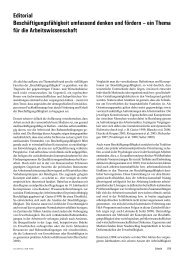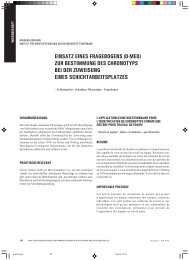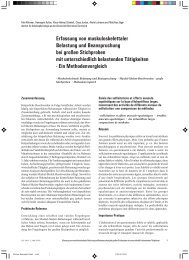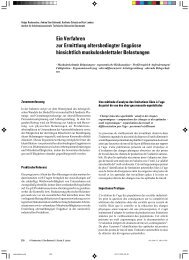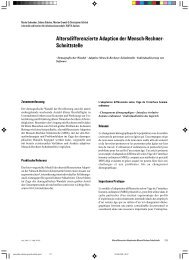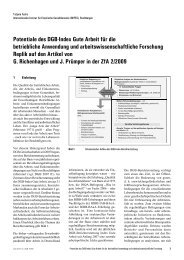Die Kunst des Alterns
Die Kunst des Alterns
Die Kunst des Alterns
Erfolgreiche ePaper selbst erstellen
Machen Sie aus Ihren PDF Publikationen ein blätterbares Flipbook mit unserer einzigartigen Google optimierten e-Paper Software.
Development of Work Physiology and Ergonomics in Germany<br />
—Tasks and Objectives in Education and Research<br />
· Work Physiology · Work Science/Ergonomics · Physiological Costs<br />
Summary<br />
Work physiology which was established as a scientific<br />
discipline in Germany around the turn from the 19th to the<br />
20th century, when the focus was on basic investigations<br />
into physical work and the human metabolism, became the<br />
germ cell of todays widely-spred work science and<br />
ergonomics. But it was a long way until in the sixties, several<br />
chairs and research institutes for work physiology, work<br />
science, and ergonomics had been founded mostly in faculties<br />
of mechanical engineering at Technical Universities. It is<br />
remarkable that the first generation of the full professors and<br />
most of the renowned founders of ergonomics had been<br />
working and had acquired their fundamental scientific<br />
education in the world-famous Max-Planck-Institute of Work<br />
Physiology in Dortmund.<br />
Meanwhile, there is no doubt that the ergonomic <strong>des</strong>ign of<br />
workplaces and the appropriate sensoric and motoric interfaces<br />
in a man-machine system according to the principle „man, the<br />
measure of all things“ would not correctly be possible if fundamental<br />
work-physiological knowledge of the characteristics<br />
of man, i.e., the capacities as well as the limitations of the<br />
human sensory organs and the hand-arm system, were not<br />
considered. Nonetheless, work physiology as a discipline in<br />
Germany has lost somewhat in popularity during recent years.<br />
This may be due to the fact that on the one hand basic<br />
knowledge has found meanwhile its way into generally<br />
applicable teaching and guiding principles of work science,<br />
and ergonomics, respectively, and on the other hand that<br />
effective research utilizing work-physiological methods needs<br />
years of experience and mostly <strong>des</strong>erves intensive and hard<br />
working as well as precisive working hypotheses and<br />
strategies. Yet, a type of working associated with something<br />
like „blood, sweat and tears“, of course, is not as popular in a<br />
new generation of researchers as experiencing „fun at work“,<br />
and getting fruitfull success, well in time via less strenuous<br />
and more softly methods. But in ergonomics research, never<br />
all claims may be given up to develop and apply methods<br />
which allow to measure „physiological costs“ of work.<br />
Assessing the ergonomic quality of, e.g., hand-held tools and<br />
computer-input devices solely by expert rating, „paper and<br />
pencil“ tests or subjective ratings could be insufficient and<br />
misleading. In order to clearly quantify what has to be invested<br />
or „paid“ by the musculature involved in work when utilizing<br />
more or less ergonomically <strong>des</strong>igned tools, also physiological<br />
measures such as multi-channel electromyography have to be<br />
applied. Similar is true for evaluating noise exposures who’s<br />
physiological costs exactly can be quantified in „figures and<br />
numbers“ by measuring threshold shifts, and their restitution<br />
if there are still reversible and not already irreversible<br />
physiological responses associated with noise.<br />
So, comparable to work-related heart rate increases and their<br />
restitution after work as specific physiological responses to<br />
dynamic muscle work during classical work-physiological<br />
investigations, also in the future it will be crucial in ergonomics<br />
to apply objective, reproducible, specified and valid experimental<br />
methods and to address concrete questions which<br />
always require a clear commitment to working on details as it<br />
was and is the case in work physiology.<br />
Practical relevance<br />
Comprehensive work-physiological knowledge of the<br />
characteristics of the human organism, always was, and will<br />
still in the future remain, a prerequisite for the truly ergonomic<br />
<strong>des</strong>ign of workplaces and user-friendly tools and products.<br />
Besi<strong>des</strong> physiological core competencies for a competent<br />
ergonomics education, work-physiological principles and<br />
paradigms are absolutely necessary for ergonomics laboratory<br />
research approaches as well for integrative applied field<br />
research aiming at the analysis, assessment and humanoriented<br />
<strong>des</strong>ign of the working environment.<br />
134 H. Strasser<br />
(61) 2007/3 Z. ARB. WISS.<br />
Strasser.pmd 134<br />
31.08.2007, 13:19



